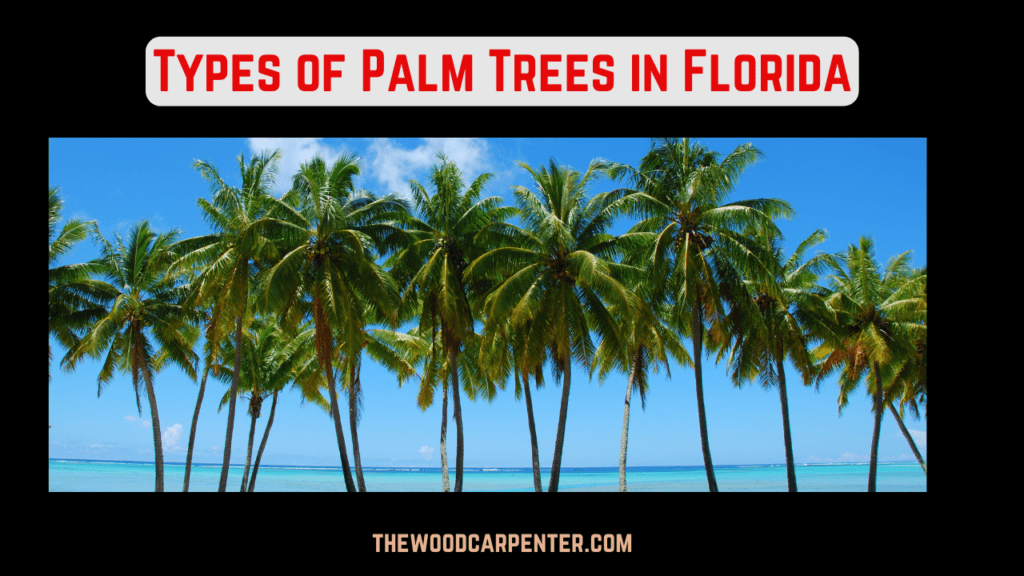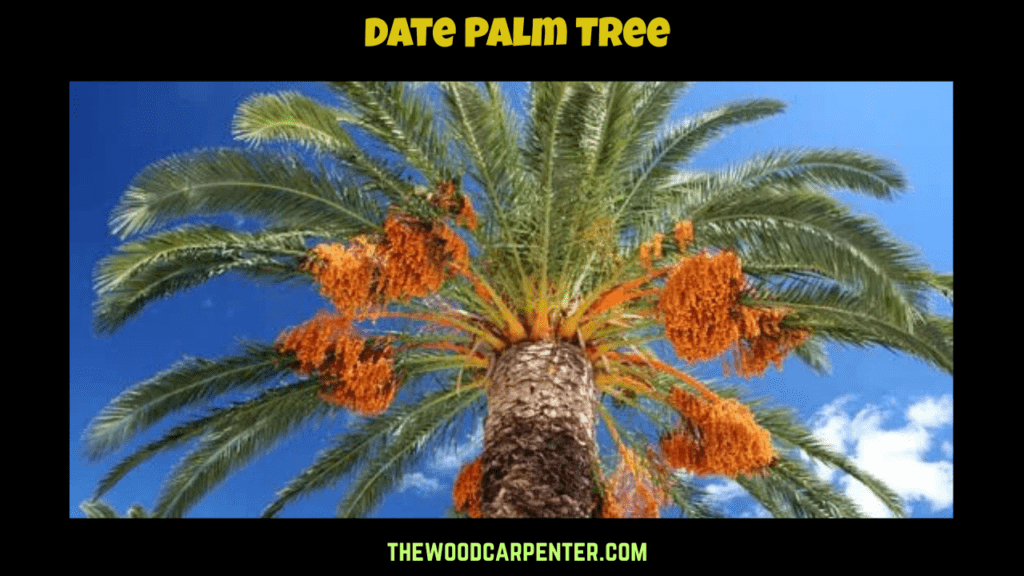
Palm Trees
Florida has a warm tropical and subtropical climate, which makes it a great place for many types of palm trees. These trees, like the famous coconut palm and the beautiful royal palm, help make Florida look naturally beautiful. They give shade, provide shelter, and are a symbol of Florida’s sunny and relaxed way of life. You can see palm trees in cities, near beaches, and all around the state. They are an important part of both Florida’s nature and its look.
The Coconut Palm
The Coconut Palm (Cocos nucifera) is one of the most famous palm trees. It has a tall, skinny trunk and big, feather-like leaves. You usually find it near the coast, where it grows well in sandy soil. This palm tree is not only pretty, but also very useful. Its coconuts give food, water, and materials that people use in many ways. It grows well in Florida’s warm weather, especially near the ocean.
What Coconut Palms Need to Grow
Coconut palms need a lot of sunlight, warm temperatures, and soil that drains water well. They also need to be watered often, especially in the hot summer. They grow best in temperatures between 72°F and 95°F.
Why Coconut Palms Are Important
Coconut palms are important for both the economy and culture. People use coconuts in food, beauty products, and even for building things in some places. The tree is also a symbol of tropical places and is often linked to vacations and beach resorts.
The Royal Palm
The Royal Palm (Roystonea regia) is a tall and beautiful palm tree with a straight trunk and big, curved leaves. It can grow as tall as 70 feet. You can often see these trees along roads and in parks throughout Florida. Their leafy tops give a grand and classy look to the area.
What It Looks Like:
Royal palms have smooth, gray trunks and large, feather-like leaves. The base of the trunk is usually a bit wider, and it gets thinner as it goes up.
Where It Grows:
These trees grow well in many parts of Florida, both near the coast and inland. They can live in different types of soil and can even handle some dry weather.
The Sabal Palm
The Sabal Palm (Sabal palmetto) is Florida’s state tree. It’s a tough palm with fan-shaped leaves and grows well in the wild. You can find it in Florida’s wetlands, near the coast, and in many natural areas.
How It Grows and Looks:
The sabal palm has a thick trunk that can grow up to 40 feet tall. Its dark green leaves look like fans and form a full top. It also produces small, black berries.
Meaning and Importance:
The sabal palm is a symbol of Florida and its strong natural environment. It appears in many official state signs and symbols. Because it’s tough and easy to grow, you’ll see it in cities, small towns, and wild areas alike.
The Date Palm

The Date Palm (Phoenix dactylifera) is a well-known palm tree in Florida, mainly because it grows tasty fruit called dates. Even though it’s often seen in dry desert places, it also grows well in Florida’s warm, sunny climate, especially in areas with soil that drains well.
What It Looks Like:
Date palms have tall trunks and long, feathery leaves. They can grow up to 60 feet high and produce small, sweet fruits that people eat.
Best Growing Conditions:
Date palms like full sun and hot weather. They do best in places that don’t have too much moisture, which makes them perfect for Florida’s dry seasons.
Why They’re Useful:
Besides looking nice, date palms are useful because of the fruit they produce. Dates are used in cooking and are enjoyed by many people. These palms also give a special look to yards and gardens, especially in drier parts of Florida.
The Foxtail Palm
The Foxtail Palm (Wodyetia bifurcata) is a newer kind of palm in Florida but has quickly become very popular. Its fluffy, full leaves look like a fox’s tail, which makes it stand out in any yard or garden.
What Makes It Special:
The foxtail palm has long, curved leaves that are thick and bushy. It grows up to 30 feet tall and has a slim trunk that turns smooth and gray as the tree gets older.
Where It’s Found in Florida:
This palm is often planted in gardens, resorts, and landscaped areas. Its unique look makes it a favorite for people who want a beautiful, eye-catching tree.
How to Take Care of It:
Foxtail palms grow best in sandy soil that drains water well. They need regular watering during dry weather. It’s also a good idea to protect them from strong winds, which can damage their soft fronds.
Also read:
Buckeye tree Wood: Good Luck Charm or Carpenter’s Curse?
Cumaru Wood: Uses, Drawbacks & Comparisons
The Areca Palm
The Areca Palm (Dypsis lutescens), also called the butterfly palm, is a popular choice for yards and business areas in Florida. It has soft, feathery leaves and grows in thick, green clumps.
What It Looks Like:
Areca palms grow several thin trunks from the same root. They are smaller palms, usually growing up to 12 feet tall. Their yellow-green leaves look a bit like butterfly wings.
Common Uses:
These palms are great for privacy because they grow in thick bunches. People also like using them as indoor plants to give rooms a tropical feel.
The Pygmy Date Palm
The Pygmy Date Palm (Phoenix roebelenii) is a small version of the larger date palm and is one of the favorite palms in Florida, especially for small yards and indoor spaces.
Best Places to Grow It:
This palm likes warm, sunny weather and doesn’t need a lot of water once it’s grown. It grows well in many types of soil and can handle slightly dry conditions.
Why People Like It:
The pygmy date palm brings a tropical look to patios, gardens, and indoor areas. It’s easy to care for and only needs light trimming and some fertilizer once a year.
The Bottle Palm
The Bottle Palm (Hyophorbe lagenicaulis) is known for its unique, bottle-shaped trunk. It’s one of the most eye-catching palm trees in Florida.
Special Look:
The bottom part of the trunk is wide and round like a bottle, and it gets thinner as it goes up. This unusual shape makes it a fun and exotic tree to have in a garden.
Where It Grows in Florida:
Even though it’s not from Florida, the bottle palm grows well in the state’s warm weather. You’ll often see it in fancy gardens and in front of homes and buildings.
How to Take Care of It:
Bottle palms are easy to care for. They like sunny spots, sandy soil, and need just the right amount of water—not too much. They don’t like cold weather, so they’re best for southern Florida. Trim off any dead leaves, and protect them from strong winds to keep them healthy.
The Needle Palm
The Needle Palm is one of the toughest palm trees you can grow in Florida. Unlike many other palms, it can handle cold weather really well. It’s a great choice if you live in a part of Florida that sometimes gets frost or chilly nights.
Tough and Low-Maintenance:
Needle Palms can survive temperatures as low as 10°F, so they’re great for northern parts of Florida. Once they’re settled in, they don’t need much water and can handle dry conditions.
What It Looks Like:
This palm has big, fan-shaped leaves and a short, thick trunk. The trunk is covered in sharp, needle-like spines—this is where it gets its name. It’s not a very tall palm, usually growing between 5 and 10 feet high.
Where to Plant It:
Needle Palms do well in shady or partly shady spots. They grow in sandy soil and can live in both coastal and inland areas. Their cold tolerance makes them perfect for cooler parts of the state.
The Cabbage Palm
The Cabbage Palm is another hardy palm that you see all over Florida, especially near the coast. It’s often used in cities and along highways, giving a classic Florida vibe.
Great for Coastal Areas:
This palm is native to Florida and loves sandy, salty soil. It’s strong enough to survive storms and salt spray, so it’s often planted near the ocean or along busy roads.
A Bit of History:
Long ago, Florida settlers used the center part of this palm (called the “heart”) as food—hence the name “cabbage.” The trunk was also used for tools and building materials.
Nice for Landscaping:
The Cabbage Palm has a tall, slim trunk and can grow up to 40–50 feet. Its large, fan-shaped leaves make it a popular pick for a tropical look, and it stands up well to strong winds.
The Mexican Fan Palm
The Mexican Fan Palm grows quickly and is easy to spot thanks to its tall, skinny trunk and wide, fan-shaped leaves. It’s a common sight in Florida’s neighborhoods, parks, and public spaces.
What Makes It Stand Out:
This palm has a long, narrow trunk with a bunch of large, fan-like leaves at the top. It can grow really tall—up to 80 feet—making it one of the tallest palms in the state.
Where You’ll Find It:
It’s often planted along streets and in open areas. Because it grows fast, it’s a good option if you want to add a big tropical look in a short amount of time.
How to Care for It:
Mexican Fan Palms need full sunlight and soil that drains well. They like regular watering, especially when it’s dry, but can handle short dry spells. Trimming off dead leaves helps keep the tree looking neat.
The Washingtonia Palm
The Washingtonia Palm is another tall and eye-catching palm that looks a lot like the Mexican Fan Palm. It originally comes from the southwestern U.S. but also does well in Florida.
How to Spot It:
This palm has a tall trunk and large, fan-shaped leaves, often with a bluish-green tint. The top of the tree has a full, leafy crown that makes it look lush and dramatic. It can grow up to 70 feet tall.
Why It Grows Well in Florida:
Florida’s warm weather is perfect for this palm. It’s best suited for large yards or open spaces where it can really stand out.
Caring for It:
Washingtonia Palms like sandy, well-drained soil and lots of sun. They can handle dry spells once they’re established but do better with regular watering. Like the Mexican Fan Palm, trimming old leaves helps it look tidy.
Palm Trees and Florida Landscaping
Palm trees are a big part of what makes Florida look and feel tropical. Whether they’re growing near the beach, in cities, or in people’s backyards, palms add a unique and relaxing vibe to the scenery. Their tall trunks, different leaf shapes, and sizes give Florida’s outdoors a lot of character.
How Palms Are Used in Landscaping
Tall palms—like the Royal Palm or Mexican Fan Palm—are often used in big open areas to grab attention or provide shade. They make great centerpieces in parks or large yards. Smaller palms—like the Pygmy Date Palm—are great for tight spaces like small gardens, patios, or courtyards. They add a tropical feel without taking up too much room.
Palms in Coastal and City Areas
In coastal parts of Florida, palms are especially useful because they can handle salty air and strong winds. That’s why you often see them near the beach. In cities, palm trees are commonly planted along streets, in parks, and next to driveways. They help make busy places look more peaceful and natural.
Frequently Asked Questions (FAQs)
Q: How many types of palm trees are there in Florida?
A: Florida boasts over 2,500 species of palms, both native and introduced, but about 30 types are commonly found in landscapes and urban areas.
Q: What is the most common palm tree in Florida?
A: The Sabal Palm (Sabal palmetto) is the most common and is also Florida’s state tree.
Q: Which palm tree is best for coastal areas?
A: The Cabbage Palm, Saw Palmetto, and Buccaneer Palm are highly salt-tolerant and ideal for coastal landscapes.
Q: Are all palm trees in Florida native?
A: No, only 11 species are native. Many popular palms, such as the Bismarck, Queen, and Foxtail Palms, are introduced from other regions.
Q: What is the tallest palm tree in Florida?
A: The Royal Palm (Roystonea regia) can reach heights up to 100 feet, making it one of the tallest palms in the state.
Q: When is the best time to plant palm trees in Florida?
A: The best time to plant palms is during spring or fall, when temperatures are moderate and rainfall is more consistent.
Q: Do palms require special care in Florida?
A: Most native palms are low-maintenance. However, some non-native species may need supplemental fertilization and protection from cold snaps.

